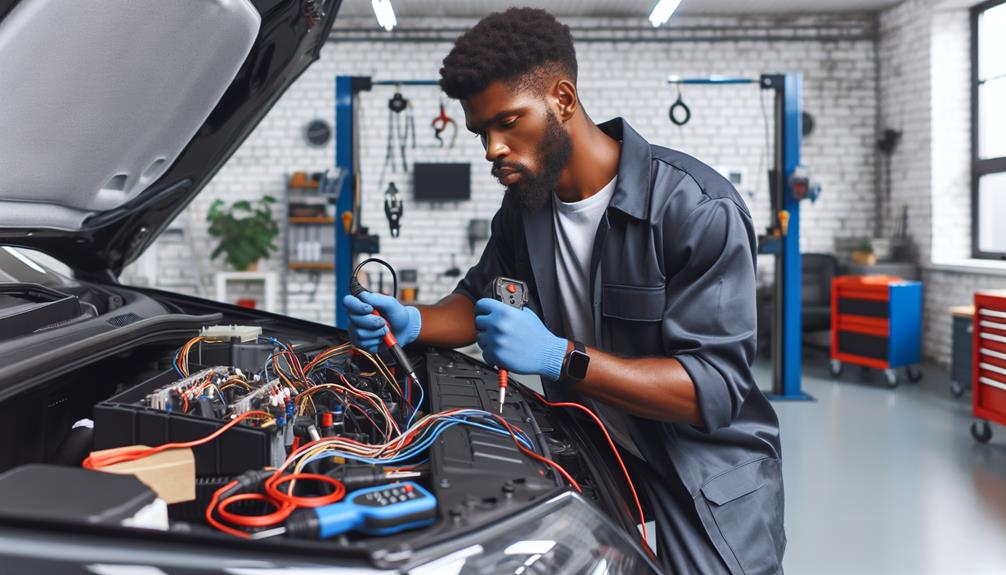Did you know that car electrical issues can be quite frustrating and can leave you stranded on the side of the road? It's a common problem that many car owners face at some point.
But fear not, because there are several common ways to fix these issues and get your vehicle up and running smoothly again. From checking the battery and connections to inspecting the fuses and relays, there are steps you can take to troubleshoot and resolve the problem.
So, if you're curious to know more about these techniques and how they can help you, keep reading to uncover the secrets of fixing car electrical issues.
Key Takeaways
- Regular battery inspection and maintenance, including visual inspection for corrosion or damage, cleaning the terminals and connections, and testing voltage and cold cranking amps, can help prevent car electrical issues.
- Checking and replacing faulty fuses and relays in the fuse box is an important step in troubleshooting car electrical problems.
- Testing the alternator and starter, including measuring voltage, inspecting the alternator belt, and performing a voltage drop test, can help identify potential issues with these components.
- Inspecting wiring and connectors for damage, corrosion, loose connections, and short circuits is crucial in diagnosing and fixing car electrical problems.
Check the Battery and Connections
To effectively diagnose and address car electrical issues, start by checking the battery and its connections. Proper battery maintenance is crucial for the optimal functioning of the electrical system in your car. Begin by visually inspecting the battery for any signs of corrosion or damage. Corrosion can hinder the flow of electricity and lead to various electrical problems. If you notice any corrosion, clean the battery terminals and connections using a mixture of baking soda and water. Be sure to disconnect the negative terminal first and reconnect it last to avoid any accidental electrical shocks.
Next, check the battery voltage using a multimeter. A fully charged battery should read around 12.6 volts. If the voltage is significantly lower, it may indicate a weak or dead battery that needs to be replaced. Additionally, test the battery's cold cranking amps (CCA) to ensure it has enough power to start the engine. If the CCA falls below the manufacturer's specifications, it's time for a new battery.
Inspect the battery's connections for any looseness or corrosion. Loose connections can cause intermittent electrical problems, while corrosion can impede the flow of electricity. Tighten any loose connections and clean the terminals and cables if necessary. Applying a thin layer of dielectric grease can help prevent future corrosion.
Inspect the Fuses and Relays
Now, shift your focus to inspecting the fuses and relays in your car's electrical system. Fuses and relays are crucial components that protect your car's electrical system from damage caused by electrical faults or overloads. By inspecting these components, you can identify any issues and troubleshoot your car's electrical system effectively.
To inspect the fuses and relays, follow these steps:
- Locate the fuse box: The fuse box is usually located under the dashboard or in the engine compartment. Consult your car's manual to find its exact location.
- Identify the fuses and relays: The fuse box contains multiple fuses and relays that control different electrical systems in your car. Use the table below to understand the function of each fuse and relay.
| Fuse/Relay | Function |
|---|---|
| Fuse 1 | Headlights |
| Fuse 2 | Brake lights |
| Fuse 3 | Power windows |
| Relay 1 | Starter motor |
| Relay 2 | Fuel pump |
- Inspect the fuses and relays: Check each fuse and relay for signs of damage, such as burnt marks or melted plastic. Replace any faulty fuses or relays with new ones of the same rating.
Test the Alternator and Starter
You'll want to test the alternator and starter in your car to ensure they're functioning properly. These two components play a crucial role in the electrical system of your vehicle. Here's how you can troubleshoot the alternator and test the starter motor:
- Alternator Troubleshooting:
- Check the battery voltage: Start by measuring the voltage across the battery terminals. A fully charged battery should have a voltage of around 12.6 volts. If the voltage is significantly lower, it could indicate a problem with the alternator.
- Inspect the alternator belt: A loose or worn-out belt can prevent the alternator from charging the battery properly. Make sure the belt is in good condition and properly tensioned.
- Starter Motor Testing:
- Check for power: Use a multimeter to measure the voltage at the starter motor terminal while attempting to start the engine. If there's no voltage, it could indicate a faulty ignition switch or a wiring issue.
- Perform a voltage drop test: Connect the multimeter between the positive terminal of the battery and the positive terminal of the starter motor. Crank the engine and check for excessive voltage drop. If the drop is too high, it might indicate a problem with the starter motor or its wiring.
Examine the Wiring and Connectors
Inspect the wiring and connectors to identify any potential issues with the electrical system of your car. Start by examining the wiring harnesses and connectors for any signs of damage, such as frayed wires or loose connections. Look for any corrosion or rust on the connectors, as this can impede the flow of electricity. Additionally, inspect the grounding points to ensure they're secure and free from corrosion.
To troubleshoot short circuits, carefully inspect the wiring for any signs of exposed or bare wires that may be touching each other or other metal surfaces. Use a multimeter to check for continuity between different points in the circuit. If there's continuity where there shouldn't be, it indicates a short circuit.
If you find any damaged wiring or faulty connectors, they'll need to be repaired or replaced. Depending on the severity of the issue, you may be able to repair the wiring by splicing in a new section or using electrical tape to insulate exposed wires. However, if the damage is extensive, it may be necessary to replace the entire wiring harness or connector.
Remember to always disconnect the battery before working on the wiring to prevent any accidental electrical shocks. It's also advisable to consult a professional if you're unsure about how to proceed with any repairs.
Diagnose and Address Faulty Components
To effectively diagnose and address faulty components in your car's electrical system, it's crucial to have a clear understanding of how each component functions and interacts with the overall system. By using troubleshooting techniques and conducting an electrical system analysis, you can pinpoint the root cause of the issue and take appropriate action.
Here are two important steps to help you tackle faulty components:
- Conduct a thorough inspection:
- Start by visually inspecting all electrical components, such as fuses, relays, switches, and motors, for any signs of damage or wear.
- Use a multimeter to test the voltage and continuity of the components. This will help you identify any faulty or malfunctioning parts.
- Test and replace faulty components:
- Begin by testing the components individually to determine if they're functioning properly. This can be done by using specialized tools or following specific procedures outlined in the car's repair manual.
- If a component is found to be faulty, replace it with a new one that meets the manufacturer's specifications. Ensure proper installation and connections.
Remember to always follow safety guidelines and consult a professional if you're unsure about any aspect of diagnosing or addressing faulty components in your car's electrical system.
Frequently Asked Questions
What Should I Do if My Car's Electrical System Keeps Draining the Battery?
If your car's electrical system keeps draining the battery, start by troubleshooting the battery drain issue. Check all the electrical connections, including the battery terminals, alternator, and starter.
Can a Blown Fuse Cause All of My Car's Electrical Components to Stop Working?
Yes, a blown fuse can cause all of your car's electrical components to stop working. For example, if the fuse for the headlights blows, you won't have any lights. It's important to check and replace blown fuses to restore functionality.
How Can I Determine if My Alternator or Starter Is the Cause of My Car's Electrical Problems?
To determine if your alternator or starter is causing your car's electrical problems, there are a few signs to look out for. Check for dim headlights, a weak or dead battery, and difficulty starting the engine.
Is It Possible for Loose Wiring or Connectors to Cause Intermittent Electrical Issues in My Car?
Yes, loose wiring or connectors can cause intermittent electrical issues in your car. To prevent this, regularly check and tighten all connections. Remember, a stitch in time saves nine.
What Steps Can I Take to Identify and Fix Faulty Components in My Car's Electrical System?
To identify faulty components in your car's electrical system, start by checking for loose connections and frayed wires. Use a multimeter to test the voltage and continuity of different parts. Replace any damaged components to fix car electrical issues.
Conclusion
In conclusion, troubleshooting and fixing car electrical issues requires a systematic approach.
By checking the battery and connections, inspecting fuses and relays, testing the alternator and starter, examining wiring and connectors, and diagnosing faulty components, you can ensure your car's electrical system functions optimally.
Just like a skilled technician meticulously analyzing the intricate circuitry, you too can unravel and resolve any electrical gremlins lurking in your vehicle, restoring it to its full power and efficiency.
- How to Easily Turn off Interior Lights in Volkswagen Tiguan 2021 - May 12, 2024
- How to Easily Defog Windshield Without AC: Quick Solutions - May 12, 2024
- How Big is 1.2 Cubic Feet: The Ultimate Guide to Measuring Volume - May 12, 2024



